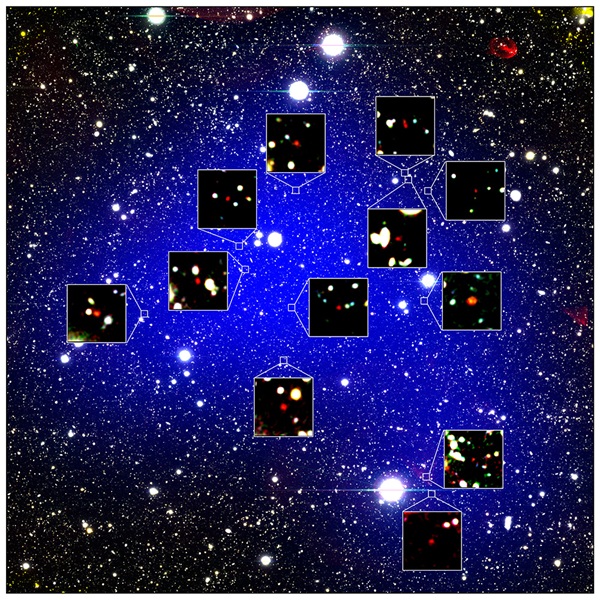Key Takeaways:
But how early in the universe’s history the clusters began to form is still unknown. Now, researchers have found the most distant and earliest example of a galaxy protocluster, a group of galaxies beginning to clump together, about 13 billion light-years away, they report in a new paper that will appear September 30 in The Astrophysical Journal. The rare find may add to astronomers’ understanding of how and when today’s galaxy clusters formed and how galaxies’ surroundings affect their evolution.

Bringing the universe to your door. We’re excited to announce Astronomy magazine’s new Space and Beyond subscription box – a quarterly adventure, curated with an astronomy-themed collection in every box. Learn More >>.
In an effort to understand the large structures that make up our universe, Harikane’s team peered deep into space. Because light takes time to travel from distant galaxies, studying those farther away means seeing the galaxies as they were long in the past.
Baby Pictures
Harikane’s team combined observations with multiple telescopes to create 3D maps of galaxies in two distant chunks of space. Both chunks mapped were so far from us that their light took billions of years to reach Earth. The result is a glimpse of what the galaxies’ looked like in the distant past.
The farther of the two was roughly 13 billion light-years away, giving us a snapshot from when the universe was only about 800 million years old.
Each of the 3D maps showed large-scale structures as expected. Galaxies weren’t spread evenly throughout space, and some spots had more galaxies than others. In particular, each of the chunks sported a grouping of galaxies that was more dense than the rest of the mapped space.
A strong hint that these groupings were the beginnings of today’s galaxy clusters came from computer simulations of dark matter, the invisible substance that makes up much of the universe’s mass. The shining stars and gases that make up galaxies, and galaxy clusters, are surrounded by massive clouds of dark matter, called dark matter halos.
The team compared the denser clumps of galaxies they observed to computer simulations of dark matter aggregating over time in the universe. The dense galactic regions showed similarities to clumps in the simulations that eventually grow to be the dark matter halos of galaxy clusters that we commonly find in the present-day universe.
The researchers conclude that the denser galaxy clumps they saw are probably precursors to these galaxy clusters, or galaxy protoclusters. This makes the farther of the two galaxy clumps they studied the earliest example of a galaxy protocluster — a baby picture of today’s galaxy clusters — ever found.
Studies like this of galaxy clusters and protoclusters at various ages may help astronomers figure out how galaxies’ childhood environment affects their evolution and properties. Evidence suggests that in the modern universe, galaxies in dense clusters tend to form stars less actively than those in less dense surroundings. But in earlier stages of galaxy clusters’ lives, this was not necessarily the case.
These clues also tell us about how — and when — our universe came to be the clumpy cosmic web that it is.










